+ Open data
Open data
- Basic information
Basic information
| Entry | Database: PDB / ID: 2nqb | ||||||
|---|---|---|---|---|---|---|---|
| Title | Drosophila Nucleosome Structure | ||||||
 Components Components |
| ||||||
 Keywords Keywords | STRUCTURAL PROTEIN/DNA / Nucleosome / NCP / chromatin / histone / STRUCTURAL PROTEIN-DNA COMPLEX | ||||||
| Function / homology |  Function and homology information Function and homology informationHDMs demethylate histones / PKMTs methylate histone lysines / Interleukin-7 signaling / Chromatin modifying enzymes / : / SUMOylation of chromatin organization proteins / Metalloprotease DUBs / E3 ubiquitin ligases ubiquitinate target proteins / Factors involved in megakaryocyte development and platelet production / RCAF complex ...HDMs demethylate histones / PKMTs methylate histone lysines / Interleukin-7 signaling / Chromatin modifying enzymes / : / SUMOylation of chromatin organization proteins / Metalloprotease DUBs / E3 ubiquitin ligases ubiquitinate target proteins / Factors involved in megakaryocyte development and platelet production / RCAF complex / RMTs methylate histone arginines / Recruitment and ATM-mediated phosphorylation of repair and signaling proteins at DNA double strand breaks / polytene chromosome band / SIRT1 negatively regulates rRNA expression / NoRC negatively regulates rRNA expression / Activated PKN1 stimulates transcription of AR (androgen receptor) regulated genes KLK2 and KLK3 / Formation of the beta-catenin:TCF transactivating complex / PRC2 methylates histones and DNA / HDACs deacetylate histones / Ub-specific processing proteases / MLL4 and MLL3 complexes regulate expression of PPARG target genes in adipogenesis and hepatic steatosis / RNA Polymerase I Promoter Escape / Regulation of endogenous retroelements by KRAB-ZFP proteins / larval somatic muscle development / RUNX1 regulates genes involved in megakaryocyte differentiation and platelet function / Senescence-Associated Secretory Phenotype (SASP) / Transcriptional regulation by small RNAs / Estrogen-dependent gene expression / HATs acetylate histones / UCH proteinases / Assembly of the ORC complex at the origin of replication / Oxidative Stress Induced Senescence / polytene chromosome / nucleosomal DNA binding / nuclear chromosome / structural constituent of chromatin / heterochromatin formation / nucleosome / nucleosome assembly / chromosome / chromatin organization / protein heterodimerization activity / chromatin / protein-containing complex binding / DNA binding / nucleus Similarity search - Function | ||||||
| Biological species |  Homo sapiens (human) Homo sapiens (human) | ||||||
| Method |  X-RAY DIFFRACTION / X-RAY DIFFRACTION /  SYNCHROTRON / SYNCHROTRON /  MOLECULAR REPLACEMENT / Resolution: 2.3 Å MOLECULAR REPLACEMENT / Resolution: 2.3 Å | ||||||
 Authors Authors | Luger, K. / Chakravarthy, S. | ||||||
 Citation Citation |  Journal: To be Published Journal: To be PublishedTitle: Comparative analysis of nucleosome structures from different species. Authors: Chakravarthy, S. / Luger, K. | ||||||
| History |
|
- Structure visualization
Structure visualization
| Structure viewer | Molecule:  Molmil Molmil Jmol/JSmol Jmol/JSmol |
|---|
- Downloads & links
Downloads & links
- Download
Download
| PDBx/mmCIF format |  2nqb.cif.gz 2nqb.cif.gz | 327.2 KB | Display |  PDBx/mmCIF format PDBx/mmCIF format |
|---|---|---|---|---|
| PDB format |  pdb2nqb.ent.gz pdb2nqb.ent.gz | 249.4 KB | Display |  PDB format PDB format |
| PDBx/mmJSON format |  2nqb.json.gz 2nqb.json.gz | Tree view |  PDBx/mmJSON format PDBx/mmJSON format | |
| Others |  Other downloads Other downloads |
-Validation report
| Summary document |  2nqb_validation.pdf.gz 2nqb_validation.pdf.gz | 515 KB | Display |  wwPDB validaton report wwPDB validaton report |
|---|---|---|---|---|
| Full document |  2nqb_full_validation.pdf.gz 2nqb_full_validation.pdf.gz | 551 KB | Display | |
| Data in XML |  2nqb_validation.xml.gz 2nqb_validation.xml.gz | 40.2 KB | Display | |
| Data in CIF |  2nqb_validation.cif.gz 2nqb_validation.cif.gz | 57.9 KB | Display | |
| Arichive directory |  https://data.pdbj.org/pub/pdb/validation_reports/nq/2nqb https://data.pdbj.org/pub/pdb/validation_reports/nq/2nqb ftp://data.pdbj.org/pub/pdb/validation_reports/nq/2nqb ftp://data.pdbj.org/pub/pdb/validation_reports/nq/2nqb | HTTPS FTP |
-Related structure data
| Related structure data |  1aoiS S: Starting model for refinement |
|---|---|
| Similar structure data |
- Links
Links
- Assembly
Assembly
| Deposited unit | 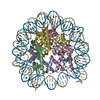
| ||||||||
|---|---|---|---|---|---|---|---|---|---|
| 1 |
| ||||||||
| Unit cell |
| ||||||||
| Details | Each nucleosome has two copies each of histones H2A, H2B, H3 and H4, and a 146 base pairs long palindromic strand of DNA derived from human alpha-satellite sequence. |
- Components
Components
-Protein , 4 types, 8 molecules AEBFCGDH
| #2: Protein | Mass: 15289.904 Da / Num. of mol.: 2 Source method: isolated from a genetically manipulated source Source: (gene. exp.)   #3: Protein | Mass: 11390.414 Da / Num. of mol.: 2 Source method: isolated from a genetically manipulated source Source: (gene. exp.)   #4: Protein | Mass: 13257.529 Da / Num. of mol.: 2 Source method: isolated from a genetically manipulated source Source: (gene. exp.)   #5: Protein | Mass: 13680.951 Da / Num. of mol.: 2 Source method: isolated from a genetically manipulated source Source: (gene. exp.)   |
|---|
-DNA chain / Non-polymers , 2 types, 266 molecules IJ

| #1: DNA chain | Mass: 45054.844 Da / Num. of mol.: 2 Source method: isolated from a genetically manipulated source Source: (gene. exp.)  Homo sapiens (human) / Gene: His3 / Production host: Homo sapiens (human) / Gene: His3 / Production host:  #6: Water | ChemComp-HOH / | |
|---|
-Experimental details
-Experiment
| Experiment | Method:  X-RAY DIFFRACTION / Number of used crystals: 1 X-RAY DIFFRACTION / Number of used crystals: 1 |
|---|
- Sample preparation
Sample preparation
| Crystal | Density Matthews: 2.64 Å3/Da / Density % sol: 53.37 % | ||||||||||||||||||||||||||||||||||||
|---|---|---|---|---|---|---|---|---|---|---|---|---|---|---|---|---|---|---|---|---|---|---|---|---|---|---|---|---|---|---|---|---|---|---|---|---|---|
| Crystal grow | Temperature: 292 K / Method: vapor diffusion, sitting drop / pH: 6 Details: Constituents of the crystallization buffer: Potassium Chloride, Manganese Chloride, and Potassium Cacodylate., pH 6.0, VAPOR DIFFUSION, SITTING DROP, temperature 292K | ||||||||||||||||||||||||||||||||||||
| Components of the solutions |
|
-Data collection
| Diffraction | Mean temperature: 93 K |
|---|---|
| Diffraction source | Source:  SYNCHROTRON / Site: SYNCHROTRON / Site:  ALS ALS  / Beamline: 5.0.2 / Wavelength: 1.1 Å / Beamline: 5.0.2 / Wavelength: 1.1 Å |
| Radiation | Protocol: SINGLE WAVELENGTH / Monochromatic (M) / Laue (L): M / Scattering type: x-ray |
| Radiation wavelength | Wavelength: 1.1 Å / Relative weight: 1 |
| Reflection | Resolution: 2.3→99 Å / Num. all: 94877 / Num. obs: 93949 / % possible obs: 98.2 % / Rmerge(I) obs: 0.045 / Net I/σ(I): 22 |
| Reflection shell | Resolution: 2.3→2.35 Å / Rmerge(I) obs: 0.302 / Mean I/σ(I) obs: 3 / Num. unique all: 5358 / % possible all: 85 |
- Processing
Processing
| Software |
| ||||||||||||||||||||
|---|---|---|---|---|---|---|---|---|---|---|---|---|---|---|---|---|---|---|---|---|---|
| Refinement | Method to determine structure:  MOLECULAR REPLACEMENT MOLECULAR REPLACEMENTStarting model: PDB entry 1AOI Resolution: 2.3→99 Å
| ||||||||||||||||||||
| Displacement parameters |
| ||||||||||||||||||||
| Refinement step | Cycle: LAST / Resolution: 2.3→99 Å
| ||||||||||||||||||||
| Refine LS restraints |
| ||||||||||||||||||||
| Xplor file |
|
 Movie
Movie Controller
Controller



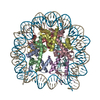
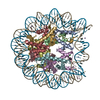
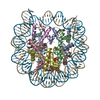
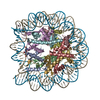
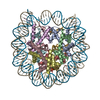
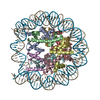

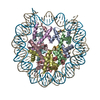

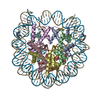
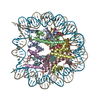
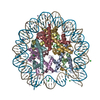
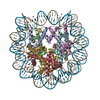
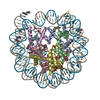
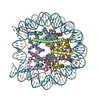
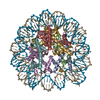
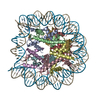
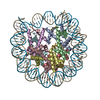
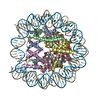
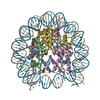
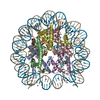
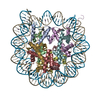
 PDBj
PDBj






































